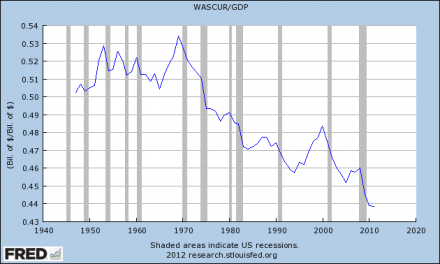It is a chart that shows the level of wages and salaries as a percentage of GDP in the United States since the late 1940s. As you can see, the slice of the pie being taken home by American workers has been dropping like a rock since about 1970....
It just so happens that President Richard Nixon closed the gold window in 1971. This action effectively took the world off the gold standard. As of that date, world currencies were free to inflate -- including the dollar.
The result?
Inflation and capital consumption, resulting in less capital per head of population and falling wages.
Exactly what Ludwig von Mises predicts in his many writings which I have quoted frequently that past couple of weeks.
Here's a relevant quote from Mises' Anti-capitalist Mentality:
All pseudo-economic doctrines which depreciate the roleWhen the dollar was tied to gold, the federal government could not inflate the currency at will without paying the consequence of a run on gold. Gold tied world currencies together. It acted as a backstop to willy-nilly monetary expansion.
of saving and capital accumulation are absurd. What constitutes
the greater wealth of a capitalistic society as against
the smaller wealth of a noncapitalistic society is the fact that
the available supply of capital goods is greater in the former
than in the latter. What has improved the wage earners'
standard of living is the fact that the capital equipment per
head of the men eager to earn wages has increased. It is a
consequence of this fact that an ever increasing portion of
the total amount of usable goods produced goes to the wage
earners. None of the passionate tirades of Marx, Keynes and
a host of less well known authors could show a weak point
in the statement that there is only one means to raise wage
rates permanently and for the benefit of all those eager to
earn wages-namely, to accelerate the increase in capital
available as against population. If this be "unjust," then the
blame rests with nature and not with man.
When Nixon ended dollar/gold convertibility, the dollar became a fiat currency, as did all world currencies pegged to the dollar. What followed was unrestrained printing of currencies (mainly to finance government spending and keep interest rates artificially low) and steady price inflation. When a currency is inflated and interest rates are kept artificially low, as they are today, there is a disincentive to save, i.e., to accumulate capital. Money saved loses its value. There is an incentive to spend capital. Thus, capital is consumed and wages fall.
We are living today with the dire consequences of Nixon's 1971 decision to end dollar/gold convertibility.

No comments:
Post a Comment